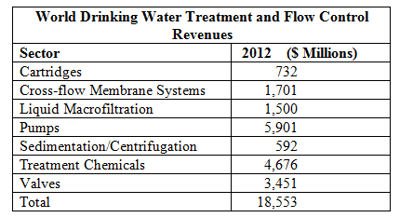World’s Drinking Water Plants to Spend $18.5 Billion on Treatment and Flow Control this Year
The world’s drinking water plants will be expanding purchases of treatment and flow control products this year by more than 5 percent. Expenditures will exceed $18.5 billion. This total is an aggregate of forecasts in a number of McIlvaine reports.

McIlvaine
Expenditures for cartridges will be relatively small due to the fact that these filters are disposable and not well suited for large flows. Liquid macrofiltration including sand filters plays a big role in purifying drinking water. Clarifiers and centrifuges are also used and result in the largest revenues in the sedimentation/centrifugation category. Also in this category are dissolved air flotation systems which provide effective separation of small particles.
Cross-flow membrane systems are finding increasing use in purifying drinking water because of their high efficiency. Reverse osmosis cross-flow systems can remove salts and are used to purify brackish water. (Desalination is included separately in McIlvaine forecasts.) Ultrafiltration and microfiltration are being utilized instead of sand filters because of their ability to capture microbes which cause diseases.
Drinking water plants will spend just under $6 billion this year for pumps. The transfer of raw water to the plants and the distribution of the drinking water to residential, commercial and industrial users involve hundreds of billions of gallons of water per day. The expansion of the drinking water infrastructure in Asia is boosting revenues in this sector.
The market for valves is somewhat smaller, but also sizable. Expenditures for treatment chemicals will exceed $4.6 billion this year. There is not only an increase in total volume of chemicals, but in the mix between chlorine and more expensive oxidants. The driver is the elimination of potentially toxic chlorine byproducts.
Source: The McIlvaine Company







